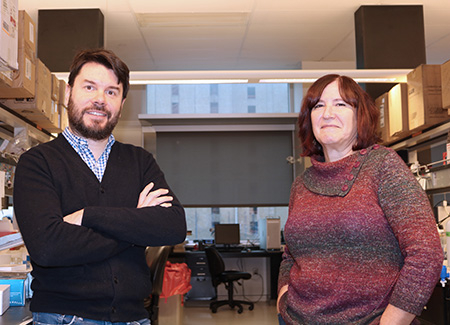Missing Protein in Brain Causes Behaviors Mirroring Autism
Rutgers-Newark scientists are studying whether there is a genetic link to autism spectrum disorder and Alzheimer’s disease

Scientists at Rutgers University-Newark have discovered that when a key protein needed to generate new brain cells during prenatal and early childhood development is missing, part of the brain goes haywire – causing an imbalance in its circuitry that can lead to long-term cognitive and movement behaviors characteristic of autism spectrum disorder.
“During brain development, there is a coordinated series of events that have to occur at the right time and the right place in order to establish the appropriate number of cells with the right connections,” said Juan Pablo Zanin, Rutgers-Newark research associate and lead author on a paper published in the Journal Neuroscience. ” Each of these steps is carefully regulated and if any of these steps are not regulated correctly, this can impact behavior.”
Zanin has been working with Wilma Friedman, professor of cellular neurobiology in the Department of Biological Sciences, studying the p75NTR protein – needed to regulate cell division – to determine its exact function in brain development, gain a better understanding of how this genetic mutation could cause brain cells to die off and discover whether there is a genetic link to autism or neurological diseases like Alzheimer’s.
Although p75NTR is not a gene specifically linked to autism, it is a part of a family of proteins needed for brain cells to develop, function and survive. The exact timing of the expression of this protein during brain development is critical.
“This protein has been examined in regard to neurodegeneration as occurs in Alzheimer’s disease and cell death after brain injury,” said Friedman, coauthor of the study. “But it has not been looked at regarding the importance it has in generating new neurons.”
Working in the laboratory with genetically engineered mice, the Rutgers-Newark scientists found that mice without the p75NTR protein had more brain cells than should normally exist – causing problems in the cerebellum, the working unit of the brain that regulates movement and balance as well as cognitive function, and is one of the key brain regions affected by autism.
In the Rutgers-Newark study, researchers trained mice – with and without the p75NTR protein – to associate a quick puff of air with a blinking light. Mice with the protein learned to blink and shut their eyes when they saw the light while mice without the protein did not.
Other scientific studies have found this same learning deficit in mice with mutations in genes that are associated with autism.
According to the Centers for Disease Control and Prevention, about one in every 59 children in the U.S. is diagnosed with autism, up from one in every 150 in 2000. Although symptoms vary, the disorder causes difficulties in social interactions with others and often results in repetitive behaviors, speech issues, memory problems and difficulties in understanding non-verbal cues.
While scientists have no clear answer as to the consequences of a brain with too many neurons, autism, primarily a genetic disease, has been associated with an unusually large brain size and some scientists think that early brain overgrowth could be a marker for the disorder.
“It is important to understand how the brain’s circuitry is built and how it regulates behavior normally,” said Friedman. “This research shows us that when it is not generated properly it is going to have an impact on many behaviors.”